2016 was a great year for our travels around England, as by the end of February we had finally visited all 48 English Counties. Third from last was Bedfordshire, and we arrived into the county town Bedford for an early morning start…
Bedford:
Status: Bedford Unitary Authority, Bedfordshire, Town, England
Date: 27/01/2016
Travel: Car
Eating & Sleeping: Travelodge Bedford Goldington
Attractions: Castle Mound, Great Ouse River, Bedford Corn Exchange, St Paul’s Church, Magistrates Court, Harpur Shopping Centre, Bedford Bridge, Market Square, John Howard Statue, Reflections of Bedford Sculpture, Bunyan Church, Howard Congregational Church, St Peter’s Church, Civic Theatre etc

My favourite scene in the town is on the High Street, where, stood in front of the magnificent Church of Saint Paul, we gazed up at the statue of John Howard (1726 – 1790, English Prison Reformer). John was born in London, but was sent to live in Bedfordshire when he was five after his mother died.
He resided in Cardington, just outside Bedford itself, and in 1773 he became the High Sheriff of Bedfordshire. He became notable in 1774 when he gave evidence to the House of Commons about the dreadful prison conditions across England, along with recommendations on how to improve them, which were taken forwards. He would go on to publish a book in 1777 called “The State of the Prisons” which covered not just England, but Europe as well, and eventually led to “Single-Celling”, where prisoners each had their own individual cells instead of all being crammed in together.
To recognise his achievements, the statue of him was erected in 1890 by Alfred Gilbert (1854 – 1934, English Sculptor who also created the Memorial Fountain (Eros) in Piccadilly Circus, London), and it stands atop what was, until 1880, a drinking fountain.
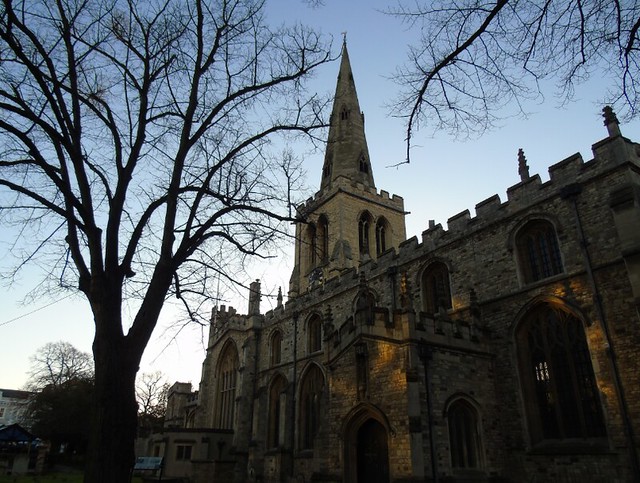
The Church behind John Howard, St Paul’s, can trace it’s origins back to Norman Times. The precursor to what we see today was completed in the 1230’s, and was used by the Monks of Newnham Priory, as well as a Parish Church, although little of it remains, aside from the South Porch. It was later rebuilt in the 15th century, sometime just prior to 1414. The reformation would take it’s toll, as the Priory was disbanded and the Church fell out of use until a grant from the family of Thomas Christie (Then MP for Bedford) in 1697.
St Paul’s was vastly enlarged around the 1770’s, where it went from a small local Church to being one of the stand out buildings in the entire county.
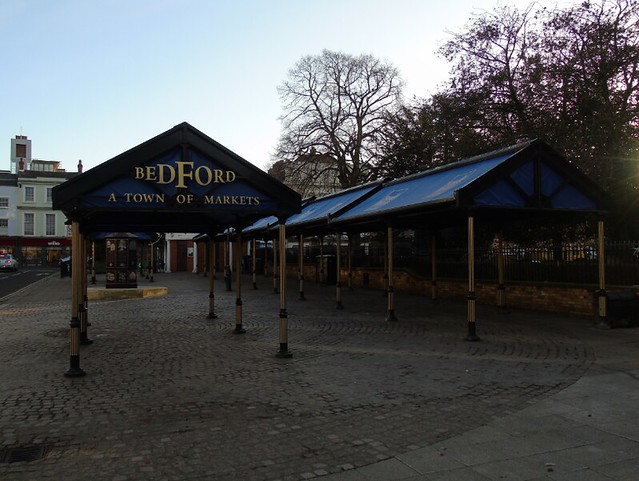
At the North End of the Church lies the towns Market Stalls, which play host to various traders, customers and products every Wednesday and Saturday.
The Bedford Market dates back to 1166, when the town was granted a Market Charter by King Henry II (1133 – 1189). It’s present location was first used in the 1500’s, however its ever expanding size meant it had to be moved to a larger site. In 2002 stalls returned to the square here, at the heart of the town centre.
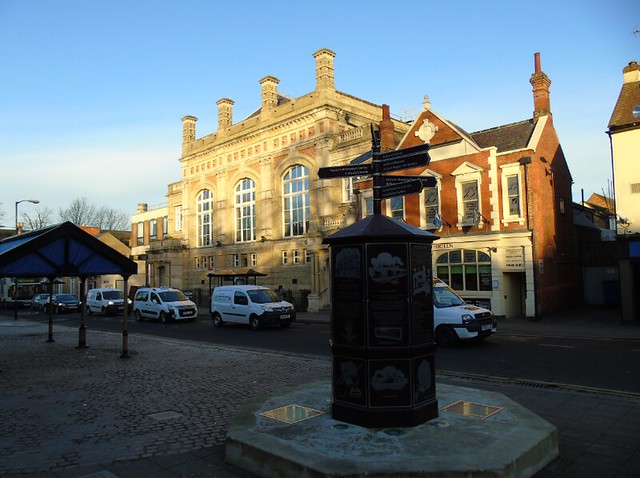
Just next to the Market Stalls stands a fantastic historical guide to the various interesting buildings in Bedford.
Each side of the post talks about a different structure, with a number for each one. This number is then also located on a map which takes up one side, allowing you to find the most historic buildings in the area.
Behind the post you can see the Bedford Corn Exchange, which opened in 1874. It became Bedford’s premier concert venue, and it remains in use for various performances throughout the year.
During World War II, the BBC Symphony Orchestra was relocated to the Corn Exchange for their safety. They were joined for 1944 by the BBC Proms, as the events previous home, the Queen’s Hall in Langham Place, Westminster, was sadly destroyed by a German bomb in 1941.
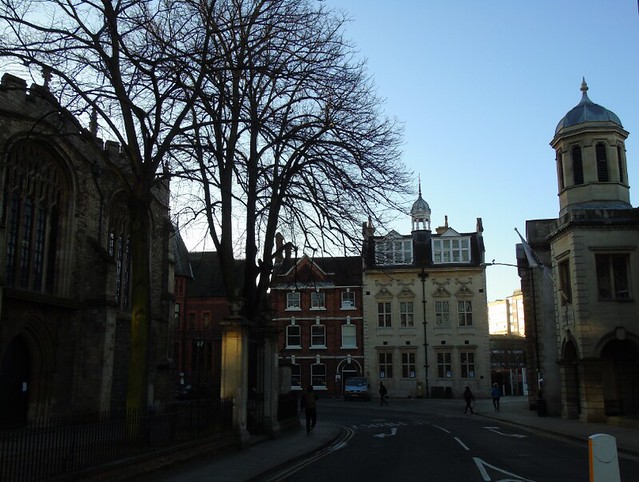
This central area of Bedford is absolutely stunning, with fine architecture in every direction.
We started to the rear of St Paul’s, outside the Civic Theatre (far right), built in 1861 by James Horsford as the Northern extension to Bedford Town Hall. The rest of the Town Hall, itself completed in 1767, is to the rear.
At the far end of the street, striking an elegant pose on it’s own is the Cowper Building, created by Basil Champneys (1842 – 1935, English Architect from London who also designed the famous John Rylands Library in Manchester). When it opened in 1886 it became part of the Girls Modern School, founded in 1882. This was later renamed the Dame Alice Harpur School, which eventually closed in 2012 after it merged with Bedford High School. Today the Council inhabit the building, which is in a prime location between the Town Hall and the adjacent Shire Hall.
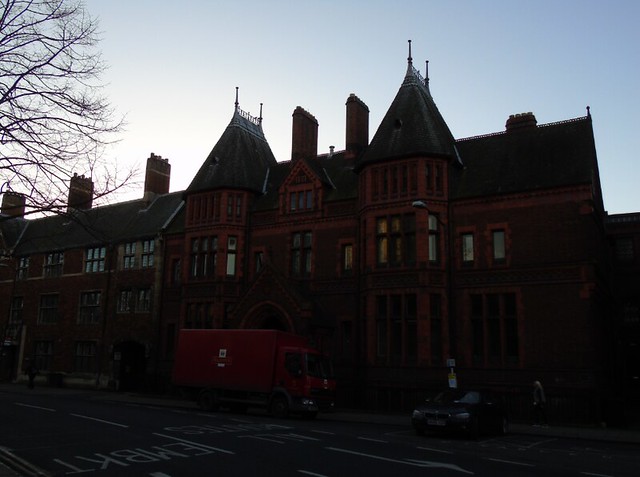
To the left of the Cowper Building is the aforementioned Shire Hall, an absolutely stunning Victorian masterpiece which looks out onto the Great Ouse River. Designed in the 1880’s by Alfred Waterhouse (1830 – 1905, English Architect from Liverpool), as a Courthouse for the town, and indeed it still fulfils this function today.
The building was extended East in 1926 by Charles Holden, which can be seen in the picture above, just to the left of the Royal Mail Van. The brickwork is a different colour, but still fits in perfectly with its surroundings.
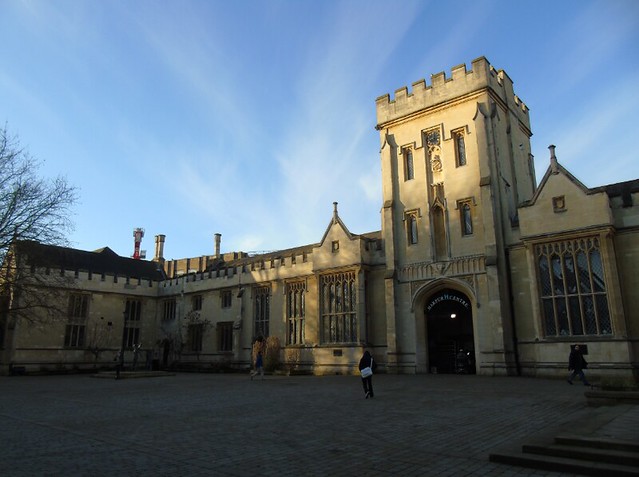
We moved North, away from the Guildhall, towards one of the towns most surprising modern additions, the “Harpur Shopping Centre”, shown above. It lies just across the road from St Paul’s Square, and what makes this particular shopping precinct interesting is that it is fronted by the old “Bedford Modern School”, whose stunning stone exterior was completed in 1834.
Prior to 1834, lessons were carried out in the adjacent Town Hall before the erection of a custom built premises. By 1974 the school had outgrown the building, so the developers moved in and created the brand new shopping centre behind it.
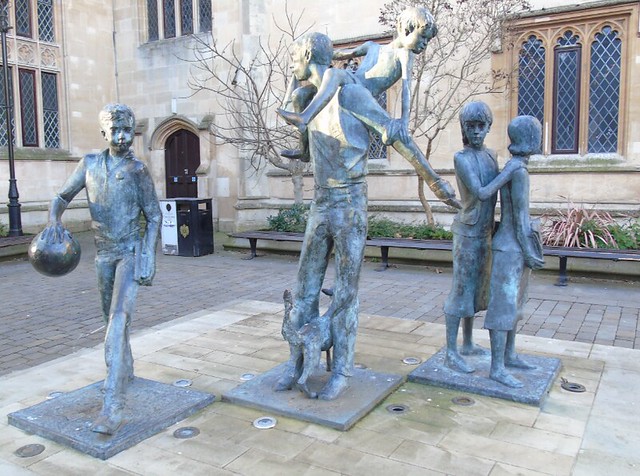
The square immediately outside the shopping centre is known as “Harpur Square”, and it is marked by an intricate statue called “The Meeting”. It is also known as the “Kid’s Statue”, and was created by John Mills.

Harpur square lies on… Harpur Street, which runs North away from the square past some of the towns main shopping thoroughfares.
Turning off onto Silver Street, we found one of the more unusual inhabitants of Bedford town centre, the “Reflections of Bedford” sculpture. Silver Street was apparently once home to a mint, and the statue is supposed to be homage to this, as well as the brick/lace trades of the town.
The designer was a man named Rick Kirby who, in 2008 had created another sculpture called the “Face of Wigan”. The design was later reused for his Bedford work in 2009, although they are slightly smaller than the 18ft original!

Heading back towards St Paul’s Square, we kept moving South, to meet the River Great Ouse, which is part way through its 143 mile journey from its source in Northamptonshire to the Wash between the Norfolk and Lincolnshire Coasts.
Crossing the river here is the Town Bridge, designed by John Wing, and officially opened in 1813. With the increase in Motor Traffic, particularly during the first half of the 20th century, it was widened in 1940, and can now accommodate two lanes of traffic in either direction.
The riverside offers a great view back at Bedford Town Centre. You can see the spire of St Paul’s Church over to the left, with the charming Swan Hotel to the right…

The Swan Hotel is a beautiful Georgian construct dating back to 1794, when it was rebuilt by Henry Holland (1745 – 1806, English Architect from London), for the then Duke of Bedford, Francis Russell (1765 – 1802, 5th Duke of Bedford). Today it is of course a hotel, with a great location next to the river.
Out in the small courtyard at the front of the building sits the South African War Memorial, which pays tribute to the British Soldiers killed during the Boer War. Sculpted by Leon Joseph Chavalliaud (1858 – 1919, French Sculptor from Rheims, France) in 1904, it is one of a number of similar memorials which can be found all over the country.

Following “The Embankment” which runs past the Swan Hotel East along the riverbank, we came across a large mound, atop which once sat Bedford Castle. Unlike many of England’s great Castles, it was only in use for a couple of centuries, however it is still one of Bedford’s most historically interesting landmarks.
Originally constructed by Henry I sometime after 1100, its first major combat role was during the period known as the “Anarchy”. This was a Civil War between Empress Matilda (daughter of Henry I) who was to be his successor after his death, and Stephen (grandson of William the Conqueror, nephew of Henry I). The war lasted from 1135 – 1154 and resulted in Stephen being installed on the throne. His successor, Henry II was Matilda’s son, restoring the correct line of the throne.
It was during the war that the Castle was attacked by Stephen on his way to tackle an invasion by the Scottish under King David, who was supporting his niece, Matilda. The Castle was later mostly destroyed after the battle. Whilst sections of the building were reinforced during the later English Civil War (1642 – 1651), most of it was left ruinous, and it was eventually demolished to make way for housing in the mid 20th century. All that remains today is part of the stone moat, where the Keep would have stood.
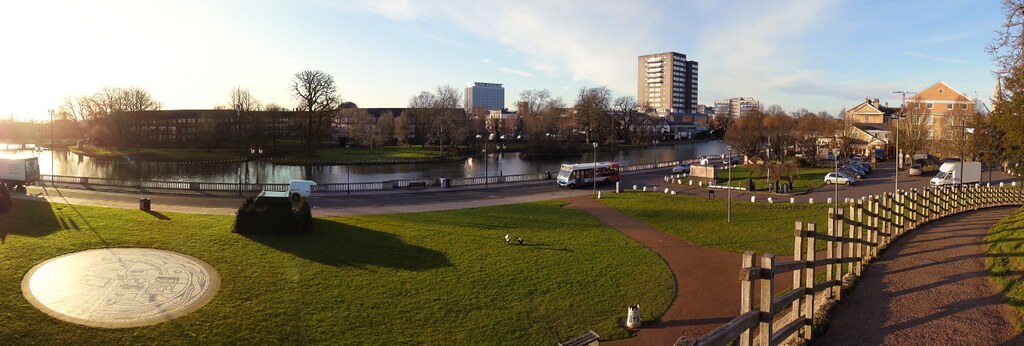
The view from the mound is stunning, looking out over the River Ouse, the Castle Park and the landmark Park Inn Hotel tower on the far side of the river, over to the right.
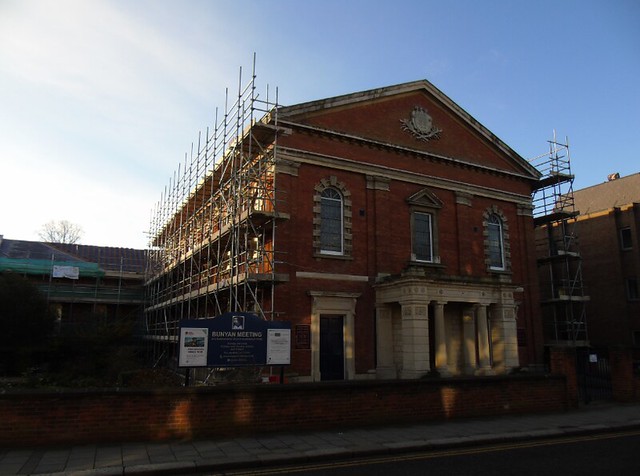
The rest of our trip to Bedford was spent exploring the many side streets which lead back from the Riverside round to St Paul’s Square, where we found a few items of interest, mainly clustered around Mill Street.
The first was the Bunyan Meeting Church, named after John Bunyan (1628 – 1688, English Writer from Elstow outside Bedford) . He was the writer of a book called “The Pilgrim’s Progress” which is widely regarded as one of the most important religious works of its era.
The Church itself was formed back in 1650, although the present building was only completed in 1849, whilst the stone porch at the front was added in 1876.

Further up Mill Street, we came across another Chapel, the “Howard Congregational Church” of 1774. The Church was founded by the aforementioned John Howard, after attempts to convert the Bunyan Church into a Methodist Church. The building was later enlarged in 1849.
The building itself is no longer used as a Church, and when I took this picture it was being converted into a new Night Club.
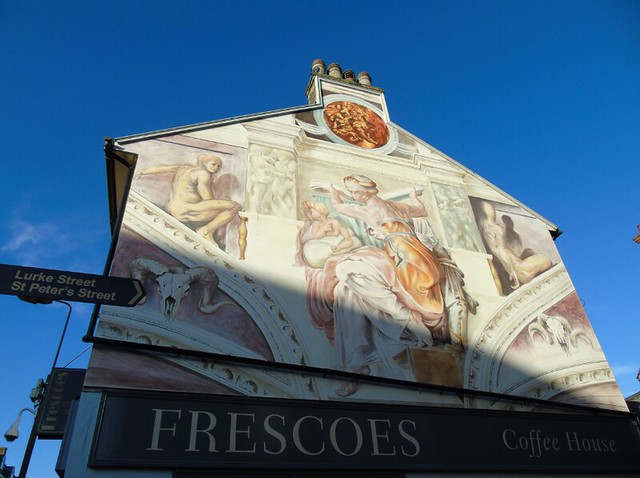
Further down the road you will find a charming little coffee house called Frescoes, which features a stunning mural on its exterior wall. It was created by a man named Iain Carstairs, who sadly passed away in early 2016 after a battle with cancer. The painting is a replica of the “Libyan Sibyl” by Michaelangelo, whose original creation can be found on the ceiling of the Sistine Chapel, in Vatican City.

Our final stop was on the outskirts of the town centre. We had stayed in a travelodge the night before, just on the edge of the city then we had driven in and parked up just round the corner from St Peter’s Church. We walked in from there, to get a good look at some of the fine Georgian town houses which line the main route into the town centre.
This charming little Church is Norman in origin, and can trace its history back to the 12th Century. All that remains of the original Church is the stunning Square Norman Tower, whilst the rest was largely rebuilt in the 15th Century, a similar story to many Churches in England. It certainly stands out as being one of the older inhabitants of the town, the perfect place to end our tour.
Bedford is a lovely little town, with plenty of great architecture around the town centre, Georgian houses around the outskirts, and a number of large, green open spaces.
Transport wise it is well connected, as it lies directly on the A6, historically an important South-North route which continues up through Leicestershire, Derbyshire, Lancashire etc. The M1 is also only a few miles away, where you can head South towards the M25 around London, or North towards Yorkshire and connections with the M6 for the North West and Birmingham.
Train services can take you direct to London and Sheffield, along with a number of other local services.
It was time to move on, and our next stop was the town of Buckingham…
